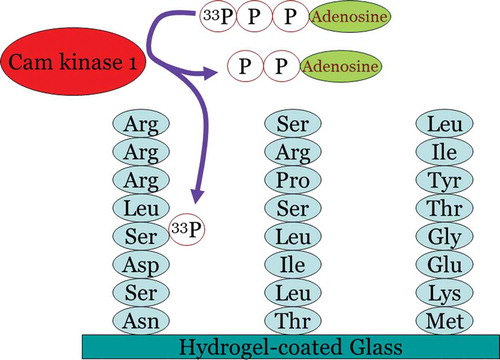Figures & data
Figure 1. Comparison of phosphorylation patterns on peptide array by lysates made from B cells from humans (left) and mice (right) One can observe that phosphorylation patterns are highly similar between the two species, thus phosphorylation of kinase substrates appears cell-type restricted and not species-restricted. Apparently the divergence in kinase primary sequence between the two species is not reflected in differences in substrate phosphorylation if a similar cell type is used. Another image from the same experiment showing the same phenomenon can also be found in [Citation6].
![Figure 1. Comparison of phosphorylation patterns on peptide array by lysates made from B cells from humans (left) and mice (right) One can observe that phosphorylation patterns are highly similar between the two species, thus phosphorylation of kinase substrates appears cell-type restricted and not species-restricted. Apparently the divergence in kinase primary sequence between the two species is not reflected in differences in substrate phosphorylation if a similar cell type is used. Another image from the same experiment showing the same phenomenon can also be found in [Citation6].](/cms/asset/729a3885-aadf-4ca4-9ae4-0c55a69bc290/ieru_a_1187564_f0001_b.gif)
Figure 2. Principle of kinome profiling using peptide arrays. A peptide array is spotted with peptide consensus motifs for the different kinases present in the human genome. As an example, in this picture the consensus sequences of three alternative kinases have been shown including CamK1 (on the left). Upon incubation with a solution that contains active CamK1 kinase and radio-active ATP, the CamK1 kinase substrate sequence will be phosphorylated by the radio-active ATP without parallel phosphorylation of the other substrates. In this fashion, kinases can be assayed in parallel.

